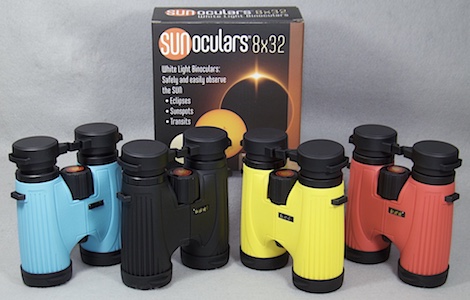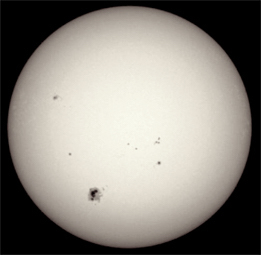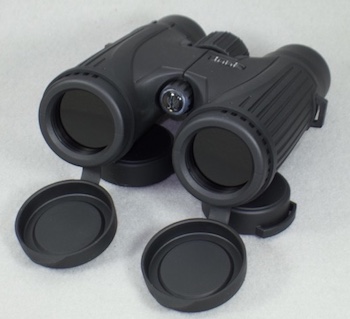Lunt Index
![]() Distribution
Distribution
![]() News
News ![]() Notes & Interesting Articles
Notes & Interesting Articles
![]()
![]() Products
Products
![]()
![]()
![]()


LUNT SOLAR SYSTEMS SUNOCULAR (SOLAR BINOCULAR) OVERVIEW
An economical white light filtered binocular with which you can safely observe sunspot activity, a planet transit, or the progress of a Solar Eclipse

Above: Lunt SUNocular solar binoculars at Company Seven (56,462 bytes).
Click on image to see enlarged view (209,034 bytes).
The SUNocular and SUNocular-Mini are products introduced by Lunt Solar Systems on 3 August 2016. These provide the user with a compact, convenient, and affordable means of safely observing aspects the Sun including Sun Spot activity (magnetic storms) or Planetary Transits. These were developed specifically with the impending Total Solar Eclipse of August 2017 in mind where millions of people across much of the USA will be able to observe this rare even. The full size SUNocular is so compact and useful that Company Seven is stocking this, ordering the small 6x SUNocular-Mini only by request. This article profiles the SUNocular 8x model.
While the SUNocular does at first glance does appear to be a conventional central focus roof-prism binocular, the SUNoculars incorporate glass solar filter elements that so reduce the amount of light passing through that these are suitable solely for examining intensely bright objects such as the Sun. The solar filters are integral components that cannot be removed (or lost), so the SUNocular cannot be employed for the observation of terrestrial objects. The light from the Sun is attenuated to a comfortable level for observing, some 10⁻⁵ (0.00001 or 1/100,000th %) transmission, while any ultra-violet and infrared components of that light are completely and safely blocked.
The binocular produces a magnification of 8x, this allows one to recognize major features on the Sun. It is easy for most people to hand hold this lightweight binocular steadily over extended observing sessions. Because it is so easy to hold there is no provision for attaching a conventional tripod adapter however, Company Seven does offer third party hardware that will allow attaching the SUNocular to a conventional camera tripod head.
Background:
 The photosphere is the visible surface of the Sun that amateur astronomers are most familiar with. This is readily observed with relatively inexpensive solar filters such as that we offer by Questar, and Baader Planetarium for example. The visible surface of the Sun is not a solid surface but is actually a layer of the gas ball that is about 100 km thick; this is relatively thin compared to the 700,000 km radius of the Sun. When observing the center of the disk of the Sun we look straight in and see somewhat hotter and brighter regions. When one observes the limb of the solar disk that light has taken a slanting path through this layer and we only see through the upper, cooler and dimmer regions. This explains the "limb darkening" that appears as a darkening of the solar disk near the limb. A number of features can be observed in the photosphere with a simple telescope or binocular equipped with a suitable “White Light” filter with a metal coated glass or polymer element, designed to attenuate the intensity of the Sun’s light to comfortable levels, and to block harmful UV and infrared portions of the spectrum.
The photosphere is the visible surface of the Sun that amateur astronomers are most familiar with. This is readily observed with relatively inexpensive solar filters such as that we offer by Questar, and Baader Planetarium for example. The visible surface of the Sun is not a solid surface but is actually a layer of the gas ball that is about 100 km thick; this is relatively thin compared to the 700,000 km radius of the Sun. When observing the center of the disk of the Sun we look straight in and see somewhat hotter and brighter regions. When one observes the limb of the solar disk that light has taken a slanting path through this layer and we only see through the upper, cooler and dimmer regions. This explains the "limb darkening" that appears as a darkening of the solar disk near the limb. A number of features can be observed in the photosphere with a simple telescope or binocular equipped with a suitable “White Light” filter with a metal coated glass or polymer element, designed to attenuate the intensity of the Sun’s light to comfortable levels, and to block harmful UV and infrared portions of the spectrum.
Right: The Sun and it’s sunspots as it may appear through a White Light Filter such as on the SUNocular (28,361 bytes).
Depending on the nature of the coating or metal used to make the solar filter the Sun may appear white, blue, yellow, or orange red. The SUNocular employs durable filtering deposited onto glass elements, these not only attenuate the Sun but also block harmful portions of the spectrum. Since these uniformly attenuate the sunlight in the visible portion of the spectrum, yet all colors still pass through and combine to show the Sun as appearing with a cream white color tone similar to the image at right.
The features of the Sun that are visible in a white light filter may include: 1. dark sunspots, 2. the bright faculae, and 3. granules, or 4. a Planetary Transit, or 5. follow the progress of a Solar Eclipse.
For the moderate cost these are pretty nicely made, and with features often lacking in conventional binoculars of their price class. These features include:

- Easy to operate central focus arrangement with adjustment mechanism to compensate for differences of diopter between the observer’s eyes.
- Retractable eyecups and sleeves, these can be left collapsed in to accommodate someone wearing prescription spectacles or or sunglass. For those not wearing glasses, the eyecups sleeves can be drawn out and extended to suit the user’s preferred eye relief.
- For better protection of the eye lenses, there is a Rain Guard that can be left attached to the carry strap. This is flipped out of the way or slipped back over the eyepiece eyecups and sleeves.
- For better protection of the objective lenses, the lenses at the front end, there are captive covers that can be flipped out of the way or snapped back over the lenses. If/when a cap is accidentally torn off or ages and comes apart, then they can be replaced by the user.
- Available in your choice of rubber armor: black, red, yellow or blue.
Mouse over the image back and forth to see alternate view showing the SUNocular but with one extended eyecup sleeve (42,617 bytes).
Included with each SUNocular:
The provided items in each SUNocular set include: the SUNocular, Soft Case, Carry Strap, Objective Lens Caps, Rain Guard, Cleaning Cloth. The accompanying limited warranty provides remedies for defects of workmanship or materials for one (1) year; impact, tampering, or immersion void the warranty.
Using The SUNocular:
WARNING: NEVER LOOK AT THE SUN WITHOUT SPECIAL EYE PROTECTION. Prior to each use inspect your SUNocular for any signs of damage, DO NOT USED IF DAMAGED as using damaged solar observing products can result in severe permanent eye injury or blindness.
To use the binocular remove the covers, set the diopter control if necessary, pull the barrels apart or bring them closer together to set the spacing to correspond to your interpupilary spacing, point the binocular to the Sun, and adjust focus as necessary. Company Seven recommends you wear sunscreen over extended observing sessions. For better comfort while observing wear a hat, this can be a Lunt cap for example, a baseball cap, or other hat with a brim that helps to shade you.


